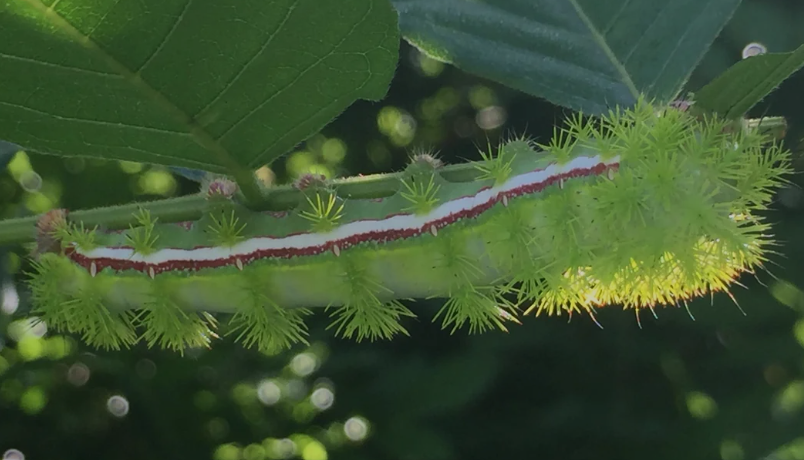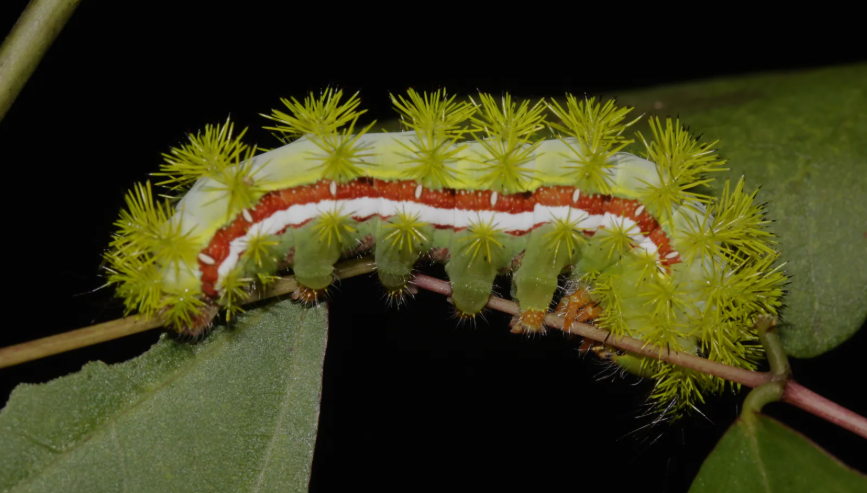
Classification
The Io Moth Caterpillar, Automeris io, is a member of the family Saturniidae, also known as the giant silk moths. This family is distinguished by its large-bodied species, many of which have striking wing patterns and vibrant larvae. Within Saturniidae, the genus Automeris is particularly noted for moths with bold hindwing eyespots, a key defensive feature against predators.
Automeris io is one of the most studied and recognizable members of this genus in North America. Like other Lepidoptera, it undergoes complete metamorphosis, passing through four distinct stages: egg, larva (caterpillar), pupa, and adult. Each stage is highly specialized, with the larval stage focused almost exclusively on feeding and growth.
Identifying Characteristics
The caterpillar of the Io moth is among the most eye-catching and memorable in North America, not only for its size but also for its vivid appearance. In its earlier instars (growth stages), the caterpillar is dark with spiny projections, which provide early protection. As it matures, it turns a vivid green, a coloration that provides camouflage among leaves.
Running along each side of its body are narrow horizontal stripes: one white and one edged with red. What makes the Io caterpillar especially distinctive are the dense clusters of green spines covering its body. These spines are urticating, meaning they can deliver venom through contact. When touched, they break the skin and inject irritating compounds that can cause stinging pain, swelling, and rashes in humans. This painful defense makes the Io caterpillar one of the few North American caterpillars that should be handled with caution.
Distribution, Migration & Habitat
The Io moth has a broad distribution across North America. Its range extends from southern Canada through much of the eastern and central United States and into parts of northern Mexico. It is most abundant in regions with temperate to warm climates, and unlike migratory butterflies such as the Monarch, the Io moth is a non-migratory species. Instead, it remains within local habitats throughout its life cycle, relying on seasonal cues for development and pupation.
Preferred habitats include deciduous woodlands, meadows, prairies, farmlands, and suburban areas where host plants are readily available. The caterpillars are especially common on vegetation near open sunny areas, as this allows them easy access to a wide variety of food plants. Their adaptability to different habitats contributes to their widespread presence.
Predators & Threats
Despite its dangerous spines, the Io caterpillar is not free from predation. Birds may occasionally prey on them if they can avoid or tolerate the stinging hairs. Parasitic wasps and flies are among the greatest threats, as they lay their eggs inside or on the caterpillar, with larvae consuming it from within. Spiders may ensnare Io caterpillars in webs, neutralizing their defenses.
As adults, Io moths lose the caterpillar’s spiny defenses and instead rely on startling predators with large eyespots on their hindwings, which resemble the eyes of an owl or other large creature. This bluff is often enough to deter small predators, but not all. Bats, nocturnal birds, and small mammals frequently prey on adult moths. Human activities also present indirect threats: habitat destruction, pesticide use, and light pollution all reduce moth survival rates.
Lifespan of Adults
The adult Io moth has a brief but striking existence. Emerging from the cocoon in late spring or summer, the moth survives for only one to two weeks. Unlike the larval stage, which is dedicated to feeding, the adult stage is focused solely on reproduction. Adult Io moths lack functional mouthparts, which means they cannot eat or drink.
Their short lives are fueled by energy reserves accumulated during the caterpillar stage. Males are agile fliers that actively seek out females, guided by pheromones released at night. Females deposit eggs in clusters on the undersides of leaves of host plants, ensuring that larvae will have an immediate food source upon hatching. After reproduction, both sexes soon die, completing the cycle.
Host Plants & Diet

The Io caterpillar is polyphagous, meaning it feeds on a wide range of plants. This dietary flexibility is a key reason for its success and wide distribution. Documented host plants include both herbaceous and woody species such as willow (Salix), elm (Ulmus), maple (Acer), oak (Quercus), clover (Trifolium), corn (Zea mays), roses (Rosa), and many others.
This broad host range makes the caterpillar adaptable to different ecosystems and capable of thriving in natural woodlands, farmlands, and even suburban gardens. The caterpillars are voracious eaters, consuming large amounts of foliage as they progress through several instars before spinning their cocoon. After pupation, they overwinter inside a tough silk cocoon, often attached to leaves or hidden in ground litter, until environmental conditions trigger their emergence as adults the following season.
Lifecycle of Io Moth Caterpillar (Automeris io)
Egg Stage
The lifecycle of the Io moth begins when the female deposits clusters of eggs on the underside of leaves of suitable host plants. The eggs are typically pale yellow and round, laid in groups of 20 to 30.
This clustering ensures that when the larvae hatch, they have immediate access to a food source and some safety in numbers. After about 10–14 days, depending on temperature and environmental conditions, the eggs hatch into tiny larvae.
Larval Stage (Caterpillar)
Upon hatching, the larvae are small, dark, and spiny, and they feed gregariously, staying in groups during the early instars. This communal feeding provides some protection from predators. As they molt through successive instars, their appearance changes significantly. By the later instars, the caterpillars are bright green with distinctive white and red stripes along their sides, and their bodies are covered in clusters of stinging spines.
These spines act as an effective defense, deterring most predators and inflicting painful reactions if touched by humans. The larval stage is the primary feeding phase, during which the caterpillar consumes large amounts of foliage to build up energy reserves. This stage lasts four to six weeks, after which the caterpillar is fully grown and ready to pupate.
Pupal Stage (Cocoon)
When mature, the Io caterpillar spins a cocoon, usually in leaf litter, on the ground, or among host plant leaves. The cocoon is composed of silk and sometimes incorporates leaves for added camouflage. Inside, the caterpillar transforms into a pupa. The pupal stage is a period of complete reorganization, as the larva’s tissues are broken down and restructured into the adult moth form.
Depending on the season, the pupal stage can last just a few weeks or, in colder regions, it may overwinter, with the adult emerging the following spring.
Adult Stage (Moth)
The adult Io moth emerges from the cocoon with striking wings. Males are typically yellow, while females are more brownish, but both sexes display the characteristic large eyespots on the hindwings. These eyespots are a powerful defense mechanism, startling predators when the moth suddenly flashes them.
Adult Io moths live for only one to two weeks because they lack functional mouthparts and cannot feed. Their sole purpose is reproduction. Males actively seek females at night using pheromonal cues, and females lay eggs soon after mating, beginning the cycle anew.